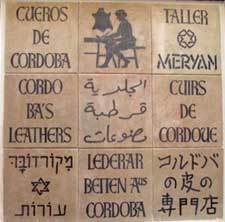Cordoba, Spain
The city of Cordoba is the
capital of Cordoba Province. It's situated at the highest navigable
point along the great Guadalquivir River, which flows westward
through the center of the Province toward Seville (138 km SW) and into the Atlantic Ocean. To the north of the city
sits the Sierra Morena Mountain Range. Population of Cordoba is
approximately 311,000 people with no significant Jewish community
today.
- General History
- Jewish History
- Visiting Today
General History
The Romans (206 B.C.E.) built the
original city on the most strategic site of the Guadalquivir River.
From Cordoba, they shipped Spanish olive oil, wine and wheat back to
Rome. They built the mighty bridge that spans the river, El Puente
Romano. But the city's greatest glory was to be achieved under the
Moors (711). Cordoba became the capital of El Andalus and was
destined to become a center of Moorish art, architecture, philosophy
and poetry.
The city's most famous landmark, Mezquita, or
Great Mosque, was one of the largest in all Islam. An investigation
into the history of this magnificent structure reveals the checkered
story of Cordoba's past. The Romans built a pagan temple on the site
which was destroyed by the Visigoths (400 - 711) when they conquered
Spain. In its stead, the Goths erected a church for St. Vincent
which, in turn, was razed by the victorious Moors, who set to work
building the Mezquita. The spectacular landmark took more than 200
years to complete and more than 1,000 pillars of granite, onyx,
marble and jasper support its arches. When the Christians seized the
city in 1236 they were awed by the beauty of the mosque and decided
to build a cathedral in the midst of its columns and arches. Another
famous monument is the Alcazar, or Fortress, which was constructed by
the Christians in 1326.
Jewish History
Cordoba plays a pivotal role in the history of
Jewish life in the middle ages. In the tenth century it became the
seat of Jewish learning, scholarship and culture, gradually eclipsing
the Babylonian academies of Sura and Pumbeditha. Its preeminence was
undoubtedly the result of the grand achievements of one man, Hasdai
Ibn Shaprut (915-970). A doctor, diplomat and scholar, Hasdai
served the courts of Caliph Abd al-Rahman III and his successor Hakam
II. His meteoric rise to power and influence brought acclaim to the
Jewish community.
Hasdai's family wealth made it possible for him to
surround himself with Jewish poets, philosophers and scholars. Under
his tutelage, the great grammarian, Menahem ben Sharuk (910-970)
completed the first dictionary of Biblical Hebrew and Aramaic, and
launched a systematic investigation into Hebrew grammar. As secretary
to the great diplomat, it was Menahem who penned Hasdai's famous
letter to the King of the Chazars. Vying for Hasdai's favor was
Dunash ben Labrat. He was a merciless critic of Menahem, and the two
maintained an intense rivalry throughout the balance of their lives.
Ben Labrat's contribution to Hebrew poetry was the introduction of
meter.
 |
Hasdai did not neglect the study of the law. He
maintained a correspondence with Saadiah Gaon, the head of the Sura
Academy and frequently sent money. His generosity earned him the
title Resh Kallah, Head of the School. But Hasdai was not content
with looking eastward for halachic guidance. He established an academy for Talmud study in Cordoba and purchased copies of the Talmud from the
Babylonian communities. Under the guidance of Moshe
ben Chanoch, the Cordoba academy flourished, becoming the
Andalusian Sura.
The Cordoba Jewish community of Hasdai's time,
situated near the alcazar, southwest of the city, was wealthy and
vibrant. But the situation would soon change. In 1013, the Berbers
lay seige to Cordoba and the city entered into a process of gradual
decline, marked by occasional periods of glory. In later years,
another famous native of Cordoba, Moses
Maimonides, would flee the city, forced out by the ferocity of
Almohade persecutions. In 1236 Cordoba was reconquered by the
Christians and the community was labeled a "scandal against
Christianity." Ferdinand and Isabella used Cordoba as their
headquarters when they waged war against the remaining Moors in
Granada, and the tribunal of the Inquisition established in Cordoba was especially cruel. Many Conversos were
martyred during the 1480's. In 1483, Jews were exiled from Andalusia.
Visiting Today
One of the only three pre-expulsion synagogues remaining in Spain, the Ancient Synagogue at Calle de los Judios 20, which was built in 1315, was declared a national monument in 1985. Nearby, a statue of Maimonides has been erected in the Plaza de Tiberiades (named to perpetuate the connection between his birthplace and where he is buried).
The entrance to the ancient Juderia is near the Almodovar Gate.
A small Jewish museum - Casa
de Sefarad - Casa de la Memoria - contains
items from local pre-expulsion Jewish homes
and also an exhibition on the Sepharadic
tradition. There is also an area dedicated
to Sepharadic (Ladino)
Music.
Sources: This material was originally published in
Sparks! - an e-zine for Jewish families located
on the Internet at http://www.sparksmag.com; Jewish Travel Guide 2006 International Edition published in association with the Jewish Chronicle |
